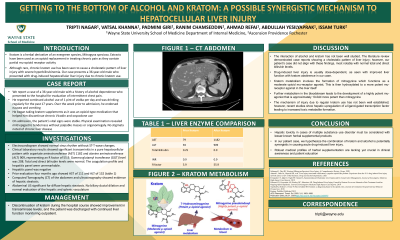Back

Poster Session E - Tuesday Afternoon
Category: Liver
E0543 - Getting to the Bottom of the Effects of Alcohol and Kratom: A Possible Synergistic Mechanism to Hepatocellular Liver Injury
Tuesday, October 25, 2022
3:00 PM – 5:00 PM ET
Location: Crown Ballroom


Tripti Nagar, MD
Wayne State University
Rochester, MI
Presenting Author(s)
Tripti Nagar, MD1, Vatsal Khanna, MD2, Padmini Giri, MD1, Ranim Chamseddin, MD1, Ahmad Refai, MD1, Abdullah Yesilyaprak, MD1, Issam A. Turk, MD2
1Wayne State University, Rochester, MI; 2Wayne State University School of Medicine, Rochester Hills, MI
Introduction: Kratom is a herbal derivative of an evergreen species, Mitragyna speciosa. Extracts have been used as an opioid replacement in treating chronic pain as they contain partial mu-opioid receptor activity (Schimmel et al.). Although rare, chronic kratom use has been seen to cause a cholestatic pattern of liver injury with severe hyperbilirubinemia. Our case presents a 36-year-old male who presented with drug-induced hepatocellular liver injury due to chronic kratom use.
Case Description/Methods: We report a case of a 36-year-old male with a history of alcohol dependence who presented to the hospital for evaluation of intermittent chest pain. On admission, the patient’s vital signs were stable. Physical examination revealed mild epigastric tenderness. Electrocardiogram showed normal sinus rhythm without ST-T wave changes. Clinical laboratory results showed significant transaminitis in a pure hepatocellular pattern with aspartate aminotransferase (AST) 1162 and alanine aminotransferase (ALT) 913, representing an R factor of 55.9. Gamma-glutamyl transferase (GGT) level was 208. Total and direct bilirubin levels were normal. The coagulation profile and hepatitis panel were unremarkable. Prior evaluation four months ago showed AST of 111 and ALT of 132. Computed Tomography (CT) of the abdomen and ultrasonography showed evidence of hepatic steatosis. Discontinuation of kratom during the hospital course showed improvement in transaminase levels, and the patient was discharged with continued liver function monitoring outpatient.
Discussion: The interaction of alcohol and kratom has not been well studied. The literature review demonstrated case reports showing a cholestatic pattern of liver injury; however, our patient’s case did not align with these findings, most notably with normal total and direct bilirubin levels. Drug-induced liver injury is usually dose-dependent, as seen with improved liver function with kratom abstinence in our case. The mechanism of injury due to regular kratom use has not been well established; however, recent studies show hepatic upregulation of a ligand-gated transcription factor leading to increased toxic metabolite formation. We hypothesize that the combination of kratom and alcohol is potentially synergistic in causing
acute drug-induced liver injury. Robust medical profiles of herbal supplementation are lacking yet crucial in clinical awareness and patient education.
Disclosures:
Tripti Nagar, MD1, Vatsal Khanna, MD2, Padmini Giri, MD1, Ranim Chamseddin, MD1, Ahmad Refai, MD1, Abdullah Yesilyaprak, MD1, Issam A. Turk, MD2. E0543 - Getting to the Bottom of the Effects of Alcohol and Kratom: A Possible Synergistic Mechanism to Hepatocellular Liver Injury, ACG 2022 Annual Scientific Meeting Abstracts. Charlotte, NC: American College of Gastroenterology.
1Wayne State University, Rochester, MI; 2Wayne State University School of Medicine, Rochester Hills, MI
Introduction: Kratom is a herbal derivative of an evergreen species, Mitragyna speciosa. Extracts have been used as an opioid replacement in treating chronic pain as they contain partial mu-opioid receptor activity (Schimmel et al.). Although rare, chronic kratom use has been seen to cause a cholestatic pattern of liver injury with severe hyperbilirubinemia. Our case presents a 36-year-old male who presented with drug-induced hepatocellular liver injury due to chronic kratom use.
Case Description/Methods: We report a case of a 36-year-old male with a history of alcohol dependence who presented to the hospital for evaluation of intermittent chest pain. On admission, the patient’s vital signs were stable. Physical examination revealed mild epigastric tenderness. Electrocardiogram showed normal sinus rhythm without ST-T wave changes. Clinical laboratory results showed significant transaminitis in a pure hepatocellular pattern with aspartate aminotransferase (AST) 1162 and alanine aminotransferase (ALT) 913, representing an R factor of 55.9. Gamma-glutamyl transferase (GGT) level was 208. Total and direct bilirubin levels were normal. The coagulation profile and hepatitis panel were unremarkable. Prior evaluation four months ago showed AST of 111 and ALT of 132. Computed Tomography (CT) of the abdomen and ultrasonography showed evidence of hepatic steatosis. Discontinuation of kratom during the hospital course showed improvement in transaminase levels, and the patient was discharged with continued liver function monitoring outpatient.
Discussion: The interaction of alcohol and kratom has not been well studied. The literature review demonstrated case reports showing a cholestatic pattern of liver injury; however, our patient’s case did not align with these findings, most notably with normal total and direct bilirubin levels. Drug-induced liver injury is usually dose-dependent, as seen with improved liver function with kratom abstinence in our case. The mechanism of injury due to regular kratom use has not been well established; however, recent studies show hepatic upregulation of a ligand-gated transcription factor leading to increased toxic metabolite formation. We hypothesize that the combination of kratom and alcohol is potentially synergistic in causing
acute drug-induced liver injury. Robust medical profiles of herbal supplementation are lacking yet crucial in clinical awareness and patient education.
Disclosures:
Tripti Nagar indicated no relevant financial relationships.
Vatsal Khanna indicated no relevant financial relationships.
Padmini Giri indicated no relevant financial relationships.
Ranim Chamseddin indicated no relevant financial relationships.
Ahmad Refai indicated no relevant financial relationships.
Abdullah Yesilyaprak indicated no relevant financial relationships.
Issam Turk indicated no relevant financial relationships.
Tripti Nagar, MD1, Vatsal Khanna, MD2, Padmini Giri, MD1, Ranim Chamseddin, MD1, Ahmad Refai, MD1, Abdullah Yesilyaprak, MD1, Issam A. Turk, MD2. E0543 - Getting to the Bottom of the Effects of Alcohol and Kratom: A Possible Synergistic Mechanism to Hepatocellular Liver Injury, ACG 2022 Annual Scientific Meeting Abstracts. Charlotte, NC: American College of Gastroenterology.
